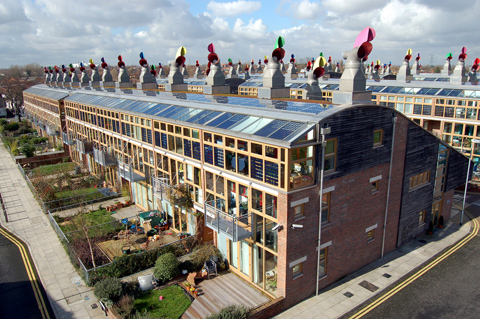A new book, Architecture & Design versus Consumerism: How Design Activism Confronts Growth (Earthscan/Routledge 2012), helps designers and design enthusiasts use activism generally and confront consumerism more particularly. This excerpt, which launches a virtual book tour during October and November, profiles potential design implications of a post-growth world.
In a post-growth scenario, our economy exists in a steady state and we don’t use consumer-driven economic growth as a central organizing principle. The book considers the design implications of several other possible organizing principles, including human and environmental health; infrastructure and maintenance; and social networks. This excerpt examines maintenance from both the space (architecture and landscape) and object (products) perspective.
Spaces and Landscapes
A major implication of a post-growth economy is the likely shift in emphasis from new build (or fabrication of new goods) to maintenance, long-term management, renovation, and retrofit. Pooran Desai’s experience of the Beddington Zero Energy housing development and related projects suggests that property management, sometimes known as facilities management or estates, is an area of opportunity — possibly for architecture and design.

London’s Bedzed inspired the idea that property management could evolve into lifestyle services that have implications for design. Photo credit: One Planet Living, Sutton, under creative commons attribution license.
Although property management currently has a reputation as the “unglamorous relation of property development,” it figures much more prominently in a steady state economy. In One Planet Communities, Desai comments:
Whereas previously we may have thought about estates management as simply maintaining the buildings and keeping the grounds tidy, if we start seeing places as communities with a positive stance on sustainability, the role of estates management takes on new meaning. The opportunity extends beyond buildings maintenance, grounds maintenance, and waste collection to embrace a host of lifestyle services.
Among these are:
- Transport services such as cycle-share and car-share schemes
- Local food links and local food delivery
- Renewable resource infrastructure
- Community events that build social capital
- Gardens and composting
- Outreach and links to the broader community
- Adaptation, upgrade, and “hacking” for the community’s own benefit
Although Desai is mainly talking about multi-family residential communities, it’s not a stretch to expand this idea to neighborhood groups, workgroups at industrial parks, or other institutions such as universities. The range of activities suggests mixing of uses and lifestyle services involving both social knowledge and spatial manifestation. The idea of architects, landscape architects, and designers getting involved in what has formerly been known as property maintenance echoes recent work in product design in the area of service design.
Products as Services
Designers have increasingly turned their attention to services, stemming from the recognition that every product has services connected to it, while all services rely on a range of products. For example, a video screen (such as a television or computer) benefits from Internet services, entertaining programs made by television networks, and related services. By designing products as service systems, or creating services that better utilize existing infrastructure, designers often increase efficiency or shift the emphasis from owning a thing to getting the services that the thing provides. The approach, described by Oksana Mont in Functional Thinking (download report), is sometimes known as “product service systems.”

A TV is part of a “product service system” – the video screen has value because of services such as television programs, Internet search engines, or video games. Photo credit: iStock.
Although the area of service design involves new views on designing a “product,” in a steady state economy, we see designers more engaged with products and spaces across time.
Implications for Buildings and Landscapes
In light of the “service” turn in product design, what does it mean for architects or landscape architects to begin engaging with servicing built environments and landscapes once they are built? For discussion purposes, let us call this the design of spatial and material services. Broadening the remit of design, expanding it across time, the design of a place is not finished upon “occupancy”; rather, design is a process that continues throughout the life cycle of the structure(s). In this case, design solutions aren’t seen as static or finished, but rather works in progress. The architect expects to come back and engage with the people, spaces, and materials — to add on to structures, to de-pave areas, to reassign outmoded elements, among other things.
This approach obviously has implications for how buildings are designed at the start, but also for different types of structures. For example, large, heavy buildings present a different case from lightweight, portable structures.
Architecture and landscape architecture are in a position to design spatial and material services particularly well because, as Jeremy Till suggests in Architecture Depends, they bring to the table a sort of spatial intelligence. An architect or landscape architect, for example, is better positioned than a property maintenance company to help a community or work group manipulate existing spatial constraints in the process of adapting to changing lifestyle conditions.
The idea of designing spatial and material services, however, confronts what Till has identified as architects’ discomfort with uncertainty, contingency, and indeterminacy. Further, it has implications for education. Just as industrial and other forms of design have seen an emergence in courses and degrees based around service design, is it conceivable that architecture or landscape architecture would see a parallel expansion?
***
To learn more about the design implications of a post-growth scenario, pick up a copy of Architecture & Design versus Consumerism (Earthscan/Routledge 2012) from Amazon.com or use the 20% discount code BRK96 at Routledge. Follow the tour on twitter #DvC12 and at these tour stops during October and November: Oct 2 and 4 — Shareable; Oct 9 —Polis; Oct 16 and 18 — Green Conduct; Oct 23 — Transforming Cultures (Worldwatch); Oct 30 — Post Growth Institute; Nov 6 — no tour stop so get out and VOTE; Nov 13 — The Dirt (American Association of Landscape Architects); Nov 20 —Proto City.
About the Author
Ann Thorpe (Ann at designactivism dot net) is a Seattle- and London-based collaborative design strategist known for her generously illustrated talks that audiences describe as “brain-opening,” “intriguing and insightful,” and full of “unusual angles.” She currently serves as strategist with a Seattle-based startup, a social enterprise called luum. She is also the author of The Designer’s Atlas of Sustainability.









